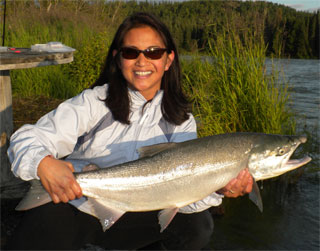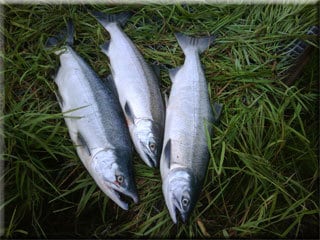
26 Jan Sockeye Made Simple
 Ahhh…, sockeye salmon season. A time when mother nature unleashes her treasure from the sea to the river and an epic migration of pristine, wild salmon floods the Kenai River. Along the shoreline, another migration ensues. A human migration gathers in equal strength, eager to intercept this tasty quarry. For unlike any other species of Alaska salmon, the sockeye or “red” salmon commands the most concentrated attention by far. Both residents and savvy visitors cherish the sockeye for it’s rich flavor and overall bounty and when the run is finally done, more than half a million of these prized fish will be harvested for food.
Ahhh…, sockeye salmon season. A time when mother nature unleashes her treasure from the sea to the river and an epic migration of pristine, wild salmon floods the Kenai River. Along the shoreline, another migration ensues. A human migration gathers in equal strength, eager to intercept this tasty quarry. For unlike any other species of Alaska salmon, the sockeye or “red” salmon commands the most concentrated attention by far. Both residents and savvy visitors cherish the sockeye for it’s rich flavor and overall bounty and when the run is finally done, more than half a million of these prized fish will be harvested for food.
Getting a freezer full of sockeye requires a small amount of preparation or homework and this will go a long way toward making sure you, like the brown bears and savvy locals, are well fed for the winter. First, if you plan to sockeye fish, you must understand it is done from shore, so you will need access to the river. In the old days, you could just target certain sections of the river and bush whack your way to the shoreline. Today, public access is limited to designated state and federal fishing parks and many offer excellent access to the river along with very good water to fish. The one problem is you will not be alone. Having private access to the river is a huge plus. Once you’ve devised a plan to access the river, it’s time to concentrate on putting the fish in the net. Lesson number one: Sockeye do not bite!!!! Feeding primarily on tiny zooplankton in the ocean, sockeye are the one salmon that does not regularly chase and kill their food. Lures that entice vicious strikes from kings or silvers, go unnoticed by the sockeye. Lesson number two: You must catch the sockeye in the mouth to keep them. Now catching a fish in the mouth that will not bite may seem an insurmountable challenge, but with the proper gear and technique, it can be done and done consistently. Lesson number three: you need fish! Even the sharpest hook and the best technique will prove futile without fish in front of you. Salmon by nature are here one minute and gone the next so it will be to your advantage to research run timing, and learn to recognize the tell tale signs that signal the run is on! If you look down a line of several anglers working the water and see no action for several minutes , that is not a good sign. If you see 2-3 fish on at once or several full stringers tied off to shore…well, that’s different. Even during prime dates, there are definitive lulls in the returns. Tides, commercial fishing, and run strength in general all have an effect on how many fish are running at any given time. The total run can be between 2 and 4 million sockeye and since managers are trying to limit the number that spawn to fewer than a million fish, the commercial nets take a large proportion. When they are out in force the pulse of fish to the river slows. When the nets are pulled, the flow of fish resumes and this ebb and flow is important toward understanding how to maximizing your time on the water. Here at our lodge at river mile 24, we estimate the fish that enter the mouth of the river will swim past our location just 24 hours later. This means we approximate the sockeye travel one mile per hour as they race upstream. Knowing the main blast of fish typically comes on a high tide, one can calculate where to be and when for the best concentrations of fish. For all the uncontrollable factors involved, there are a handful you can use to your advantage and this always helps. Perhaps the most valuable lesson to lean about catching sockeye is the technique. This begins with having the right gear:
-A medium to heavy weight bait cast, spin cast or fly fishing pole.
-20-30 lb. test line.
-2/0 octopus super sharp hooks.
-Colored yarn
-20-30 lb test leader material.
-1 ounce banana sinkers
-Pliers
-Hook file
Once you have accumulated all the above supplies, its time to put on your hip boots or chest waders and head for the river. Once you get there, string up your rod and tie your main line to the barrel swivel end of the one ounce banana sinker. Tie a five foot – 20-30 lb. leader to the bead chain end of the banana swivel. Make sure to practice tying bait loops before hand and even pre-tying a number of leaders prior to fishing would be a great plan. Now that you are all tied up with a weight, a leader and a sharp hook, one minor detail is missing. You will need a small piece of yarn affixed to your hook to make your offering legal. Now you are officially ready to sockeye fish. If you are worried about where to find all this equipment, there are several options. You can order all of it on-line via stores like Cabelas or bass pro, etc…or perhaps the easiest and cheapest choice is to buy it all here in Soldotna. All of our local tackle store will have exactly what you need at the best prices. If you do not want to travel with your own fishing rod, you can buy an adequate rod and reel combo here for less than $40. Remember all fishing gear is provided for you while guided but if you plan to spend some time targeting sockeye, a little preparation and understanding will help you maximize your time fishing on your own.
 Back to the water. Armed for battle, the first order of business is to pull out a length of line from the reel that equals roughly one and half times the length of your rod (so, if you are using a 8.5 foot rod, you’ll need roughly 12 feet of line from reel to hook.) With this loose line dangling from the tip, you want to face the river with one foot forward almost like a baseball pitcher getting the sign from the catcher and preparing to go into his windup. With your right hand holding the fishing rod and your left hand holding the fishing line 6-8 inches up from the reel, you want to make a big counterclockwise swing behind and over your head finally plunking the one ounce banana weight firmly into the river in front of you at a slight upstream angle. If you were looking at a clock, you’d want your weight to enter the water at 10-11 o’clock and with considerable force. You want to direct the weight with the rod tip and force it into the water as opposed to just following it and letting it fall in on its own. The reason for this is to get it to the bottom as fast as possible, as until your weight touches the bottom of the river, your leader will not be in position to make contact with the migrating salmon. Once you see your weight splash into the river, the next step is to drop your rod tip down to the water’s surface and pull it swiftly downriver and toward shore just fast enough to still feel your weight ticking the bottom of the river. If you pull toward shore too fast, and loose the bottom, your leader will be up and out of the “zone.” If by contrast you pull too slow, your weight will get snagged in the rocks and your leader will be too limp and coiled to be effective. The key is to pull at such a speed that your leader follows your weight perpendicular to the shoreline: as straight as possible. This will consistently pull your leader directly through the highest concentrations of fish thus giving it the best chance to run through the opening and closing kypes of the migrating salmon, and ultimately leading your razor sharp hook directly into the corner of the salmon’s jaw. One finale, very important caveat to this technique is to pick the most likely migration path in front of you, the place you visualize the most fish going through at any given time, and just as your leader is passing through this section, increase the speed of your rod tip leading your leader and in one fluid and rapid fire motion, lift your line from the river by snapping it toward shore and continuing into another big counter clockwise swing behind you. Again, another PLUNK!, into the river….feel for that first tap of the weight, leader your leader across (keep it straight!)….snap it sideways and whoa that is different….hold on!!! Now all this takes considerable rhythm and cadence and must be well practiced before getting in tune with the technique. Alas, the learning will come complete with plenty of hits and misses but soon you will come to understand and visualize not only the salmon marching upriver just feet from your standing position but also your weight and pursuant leader being repetitiously retrieved with pinpoint accuracy directly through the salmon’s migration path. I liken it to a well oiled mouse trap and once you master the timing of this unique pursuit, you too will find: sockeye made simple.
Back to the water. Armed for battle, the first order of business is to pull out a length of line from the reel that equals roughly one and half times the length of your rod (so, if you are using a 8.5 foot rod, you’ll need roughly 12 feet of line from reel to hook.) With this loose line dangling from the tip, you want to face the river with one foot forward almost like a baseball pitcher getting the sign from the catcher and preparing to go into his windup. With your right hand holding the fishing rod and your left hand holding the fishing line 6-8 inches up from the reel, you want to make a big counterclockwise swing behind and over your head finally plunking the one ounce banana weight firmly into the river in front of you at a slight upstream angle. If you were looking at a clock, you’d want your weight to enter the water at 10-11 o’clock and with considerable force. You want to direct the weight with the rod tip and force it into the water as opposed to just following it and letting it fall in on its own. The reason for this is to get it to the bottom as fast as possible, as until your weight touches the bottom of the river, your leader will not be in position to make contact with the migrating salmon. Once you see your weight splash into the river, the next step is to drop your rod tip down to the water’s surface and pull it swiftly downriver and toward shore just fast enough to still feel your weight ticking the bottom of the river. If you pull toward shore too fast, and loose the bottom, your leader will be up and out of the “zone.” If by contrast you pull too slow, your weight will get snagged in the rocks and your leader will be too limp and coiled to be effective. The key is to pull at such a speed that your leader follows your weight perpendicular to the shoreline: as straight as possible. This will consistently pull your leader directly through the highest concentrations of fish thus giving it the best chance to run through the opening and closing kypes of the migrating salmon, and ultimately leading your razor sharp hook directly into the corner of the salmon’s jaw. One finale, very important caveat to this technique is to pick the most likely migration path in front of you, the place you visualize the most fish going through at any given time, and just as your leader is passing through this section, increase the speed of your rod tip leading your leader and in one fluid and rapid fire motion, lift your line from the river by snapping it toward shore and continuing into another big counter clockwise swing behind you. Again, another PLUNK!, into the river….feel for that first tap of the weight, leader your leader across (keep it straight!)….snap it sideways and whoa that is different….hold on!!! Now all this takes considerable rhythm and cadence and must be well practiced before getting in tune with the technique. Alas, the learning will come complete with plenty of hits and misses but soon you will come to understand and visualize not only the salmon marching upriver just feet from your standing position but also your weight and pursuant leader being repetitiously retrieved with pinpoint accuracy directly through the salmon’s migration path. I liken it to a well oiled mouse trap and once you master the timing of this unique pursuit, you too will find: sockeye made simple.
